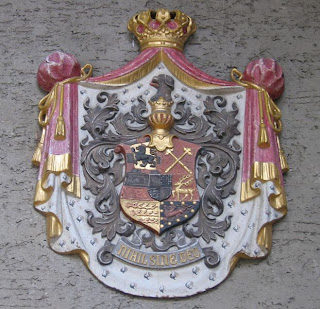Sunday Deposed Monarch Blogging: House of Hohenzollern-Sigmaringen
 The House of Hohenzollern-Sigmaringen came into existence in 1576 as the result of one of many splits within the original House Hohenzollern. Unlike their more famous Franconian cousins, the Hohenzollern-Sigmaringen House remained Roman Catholic. For almost 300 years, the family ruled over the small principality of Hohenzollern-Sigmaringen, between Baden and Wurttemberg. The principality became formally independent in 1815, but was eaten by Prussia in 1849.
The House of Hohenzollern-Sigmaringen came into existence in 1576 as the result of one of many splits within the original House Hohenzollern. Unlike their more famous Franconian cousins, the Hohenzollern-Sigmaringen House remained Roman Catholic. For almost 300 years, the family ruled over the small principality of Hohenzollern-Sigmaringen, between Baden and Wurttemberg. The principality became formally independent in 1815, but was eaten by Prussia in 1849.
Like most other German royalty during the year of re-unification, the formal elimination of their state’s independence did not result in political irrelvance. The last Prince of Hohenzollern-Simaringen briefly served as Minister-President of Prussia. The decay of the Ottoman Empire, however, would give the House its greatest opportunity. In 1866 Romania, the product of the recent union of Wallachia and Moldavia, tossed out its prince and appointed Charles of Hohenzollern-Sigmaringen as its new monarch. The Principality of Rumania remained under nominal Ottoman control until 1878, when it became independent as a result of the Russo-Turkish War. Charles was crowned as Carol I, King of the Romanians, in 1881. Romania grew slightly as a result of the Second Balkan War in 1913, and after enduring German and Austria occupation for two years, acquired Transylvania following the First World War. The entry of Romania into the war on the Allied side created some tension in greater House Hohenzollern. King Ferdinand acquired the nickname “the Loyal” from his Romanian subjects, but Kaiser Wilhelm II erased his name from the Hohenzollern House register and connived to have him excommunicated by Pope Benedict XV. The annexation of Transylvania created the historically largest Romania ever, but one which included substantial non-Romanian ethnic minorities.
The death of Ferdinand I in 1927 led to a crisis in the monarchy, as Carol II was tempermentally unsuited to assuming the throne. Consequently, the six year old Michael I became King, supported by a three member regency. In 1930 Carol II got bored of wandering Europe with his mistress and returned to Romania. A group of dissatisfied politicians managed to depose Michael I and crown Carol II king. Carol II ruled for ten years, lost Bessarabia to the Soviets, and watched as the Romanian government devolved into fascism. Carol II abdicated under German pressure in 1940, moving to Portugal and returning Michael I to the throne.
 In June 1941, Romania joined the Nazi crusade against Soviet Russia. Like all armies allied to the Germans, the Romanians suffered from poor equipment and limited spares. The Russians took advantage of this to devastating effect at the Battle of Stalingrad, where the collapse of two Romanian armies in the face of a fierce Soviet offensive resulted in the encirclement of the German Sixth Army. German efforts to relieve Stalingrad failed, and the Soviets won one of the most critical battles of the war. In August 1944 Michael I played a crucial role in an anti-Nazi coup, which reversed Romania position in the war and facilitated a quick Soviet occupation of the country. Michael I was awarded a Legion of Merit by President Truman and an Order of Victory by Stalin in recognition of his contribution.
In June 1941, Romania joined the Nazi crusade against Soviet Russia. Like all armies allied to the Germans, the Romanians suffered from poor equipment and limited spares. The Russians took advantage of this to devastating effect at the Battle of Stalingrad, where the collapse of two Romanian armies in the face of a fierce Soviet offensive resulted in the encirclement of the German Sixth Army. German efforts to relieve Stalingrad failed, and the Soviets won one of the most critical battles of the war. In August 1944 Michael I played a crucial role in an anti-Nazi coup, which reversed Romania position in the war and facilitated a quick Soviet occupation of the country. Michael I was awarded a Legion of Merit by President Truman and an Order of Victory by Stalin in recognition of his contribution.
Soviet occupation was not kind to King Michael. Efforts at resistance proved futile, and Michael abdicated and fled the country in January 1948. Accounts differ as to the amount of money Michael escaped with. Since his abdication (which Michael later denounced as coerced and illegitimate), Michael has lived in Britain and Switzerland. In 1992 he visited Romania for Easter, and was greeted by huge and enthusiastic crowds. Apparently seeing this enthusiasm as a threat, the Romanian government banned Michael from visiting for another five years. Michael’s citizenship was restored in 1997, and he has since been a strong public advocate for Romanian interests in Europe.
 Prospects for restoration are mixed. Michael remains relatively popular in Romania, but pro-monarchist parties haven’t had much political success. Michael I has five daughters but no sons, and because Romanian law prohibits female succession, the heir to the throne will become Friederich William of Hohenzollern upon Michael’s death.
Prospects for restoration are mixed. Michael remains relatively popular in Romania, but pro-monarchist parties haven’t had much political success. Michael I has five daughters but no sons, and because Romanian law prohibits female succession, the heir to the throne will become Friederich William of Hohenzollern upon Michael’s death.
Trivia: Three successive monarchs of what dynasty managed a total of 135 years of rule?


